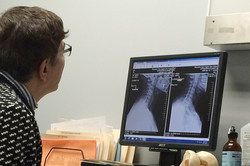- Home
- About Us
- TSPT Academy
- Online Courses
-
Resources
- Newsletter
- Business Minded Sports Physio Podcast
- Day in the Life of a Sports PT
- Residency Corner
-
Special Tests
>
-
Cervical Spine
>
- Alar Ligament Test
- Bakody's Sign
- Cervical Distraction Test
- Cervical Rotation Lateral Flexion Test
- Craniocervical Flexion Test (CCFT)
- Deep Neck Flexor Endurance Test
- Posterior-Anterior Segmental Mobility
- Segmental Mobility
- Sharp-Purser Test
- Spurling's Maneuver
- Transverse Ligament Test
- ULNT - Median
- ULNT - Radial
- ULNT - Ulnar
- Vertebral Artery Test
- Thoracic Spine >
-
Lumbar Spine/Sacroiliac Joint
>
- Active Sit-Up Test
- Alternate Gillet Test
- Crossed Straight Leg Raise Test
- Extensor Endurance Test
- FABER Test
- Fortin's Sign
- Gaenslen Test
- Gillet Test
- Gower's Sign
- Lumbar Quadrant Test
- POSH Test
- Posteroanterior Mobility
- Prone Knee Bend Test
- Prone Instability Test
- Resisted Abduction Test
- Sacral Clearing Test
- Seated Forward Flexion Test
- SIJ Compression/Distraction Test
- Slump Test
- Sphinx Test
- Spine Rotators & Multifidus Test
- Squish Test
- Standing Forward Flexion Test
- Straight Leg Raise Test
- Supine to Long Sit Test
-
Shoulder
>
- Active Compression Test
- Anterior Apprehension
- Biceps Load Test II
- Drop Arm Sign
- External Rotation Lag Sign
- Hawkins-Kennedy Impingement Sign
- Horizontal Adduction Test
- Internal Rotation Lag Sign
- Jobe Test
- Ludington's Test
- Neer Test
- Painful Arc Sign
- Pronated Load Test
- Resisted Supination External Rotation Test
- Speed's Test
- Posterior Apprehension
- Sulcus Sign
- Thoracic Outlet Tests >
- Yergason's Test
- Elbow >
- Wrist/Hand >
- Hip >
- Knee >
- Foot/Ankle >
-
Cervical Spine
>
- I want Financial Freedom
- I want Professional Growth
- I want Clinical Mastery
 We all have the patients that are obsessive over their diagnostic imaging findings. They are fearful for you to even evaluate them without reading their MRI reports. Some of the most distressing words we hear as clinicians can be, "have you seen my imaging reports?" Immediately, the patient is at risk for becoming a slow responder due to the presence of perceived threats from the reports. Recently, I had a patient who had an MRI that revealed some disc herniation in her lumbar spine. I tried to educate both the patient's family and another involved health care practitioner on how disc abnormalities can be normal in teenagers and twenty-year-olds as many are asymptomatic with those same problems. No matter what I said, there was a level of fear in that patient's family (likely heightened by the confirmation from the other practitioner) that could not be shaken. Recently, a study came out showing just how common disc bulges can be. Between 70-78% of asymptomatic individuals in their twenties have a disc bulge in their cervical spine. This further increases the evidence of how it is a normal aging process. The fear instilled by imaging can be difficult to treat. It is by far my weakest area as a physical therapist. I used to think it would apply to a small population, but it appears to become ever more important with the progression of pain science. I currently am reading Therapeutic Neuroscience Education and have read Explain Pain in order to develop my methods of educating patients on pain science. What other sorts of resources or methods do you use in this area? -Chris
4 Comments
3/18/2015 01:04:47 am
Chris,
Reply
Steve
3/18/2015 01:58:32 am
JAMES---any chance you are now 'experienced' enough to be a CI?
Reply
3/18/2015 02:35:28 am
I find using logical arguments to make people realize pain is not a threat (or imaging) works well. For example, in that case, like many, pain is intermittent, it may take a bit more questioning for them to realize that. If they end up saying their pain is worse in the morning, but better as the day goes on, you can ask them, "Do you think your MRI looks worse in the morning, and then improves as the day goes on?" Replace that with movements, positions of ease and irritation and most people realize the MRI is just what their spine looks like when they're lying in a tube.
Reply
3/21/2015 09:28:38 pm
Starting up my stopthoughtviruses.com again with infographics for the public and clinicians. http://www.stopthoughtviruses.com/2015/03/low-back-pain-and-imaging.html
Reply
Leave a Reply. |
Dr. Brian Schwabe's NEW Book in partner with PaleoHacks!
Learn residency-level content on our
Insider Access pages We value quality PT education & CEU's. Click the MedBridge logo below for TSPT savings!Archives
July 2019
Categories
All
|






 RSS Feed
RSS Feed